In the last Terminator movie, an aging, saggy Arnold tells his younger, time-traveling and still-buff self: I have been waiting for you.
Well, me too.
For the SkyD diesel engine that Mazda was going to offer in the Mazda3 sedan/hatch. This was supposed to have happened in 2015, as a follow-up to the gorgeously restyled, all-new (in 2014) Mazda3 itself.
Then the VW Diesel Debacle happened – and Mazda withheld. I do not blame them. EPA has become Inspector Javert-like when it comes rto diesels. Achieiving “compliance” with almost-impossible emissions standards without compromising the fuel efficiency and performance of diesel engines is neither easy nor cheap.
The good news – apparently – is that the SkyD diesel engine is coming. Just not this year. And not in the Mazda3 (it will debut in the CX-5 next year).
But it’s not all bad news.
The Mazda3 remains a sparkling standout in the economy car segment – chiefly because it neither looks like nor drives like an economy car, despite it being a very economical car both to drive and to buy.
WHAT IT IS
The Three is Mazda’s smallest, least-expensive car . . . that also happens to be an impressively good-looking, fun to drive and affordable car. 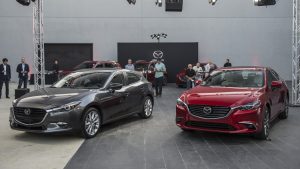
It’s sold in both sedan and hatchback (five door) versions, with either of two available four cylinder engines and – most unusually – your pick of a manual or automatic transmission with either engine.
While many cross-shops offer the choice of a manual or automatic transmission with their standard (usually, low-performance) engines, very few give you the option to shift your own gears with the optional/upgrade engine. In most cases, if you want the extra power, you have to accept the mandatory-with-the-optional-engine automatic transmission.
Not here.
The Three also comes standard with an impressive roster of amenities, including a seven inch LCD touchscreen and HD six speaker stereo with the ability to stream Internet radio through your smartphone.
And it offers as optional equipment unusual-for-the-class features such as a Heads Up Display (HUD), a heated steering wheel and adaptive cruise control with automated/emergency braking technology.
Prices start at $17,845 for the base (Sport trim) sedan with 2.0 liter engine and six-speed manual transmission; the same thing in a five-door hatchback stickers for $19,095.
A top-of-the-line Gran Touring sedan with the larger, more powerful 2.5 liter engine and automatic transmission lists for $24,195. The same basic thing in a five-door hatchback lists for $24945.
WHAT’S NEW
All trims get styling tweaks to the nose and tail, as well as a revised dash design and new steering wheel – as well as a new, electronic handling assist Mazda calls G Vectoring Control. It uses subtle application of brake force during hard cornering to correct the car’s line – and keep the tail from swinging wide (oversteer) or the front end from tucking in toward the inside of the curve (understeer).
Also, the pull-up emergency brake lever has been nixed in favor of a push-button electronic parking brake. This frees up center console space but eliminates freestyle bootleg turns.
It is possible Mazda will put the SkyD diesel engine into the bullpen later this year – but probably not until next year.
WHAT’S GOOD
Economical to operate – the 2.0 engine can tickle 40 MPG on the highway – but not a snore to drive.
Doesn’t look economical.
Sedan or hatchback layout.
No turbos – with either engine.
Several unusual-for-the-class standard and optional features.
Standard LCD touchscreen is large but still back and white (color costs extra).
Backseats are a bit less roomy than rivals like Civic and Corolla.
Sedan’s trunk is small for the class (12 cubic feet).
Still no SkyD diesel.
UNDER THE HOOD
Two things of particular interest about the Mazda3’s motive sources.
First, neither the standard 2.0 liter nor the optional 2.5 liter four cylinder engine are turbo-goosed – bucking what seems an irresistible trend toward engine that are accessorized with an air pump (which is what a turbo is – and does).
Instead, Mazda uses very high compression (13.0:1 for both the 2.0 and 2.5 liter engine) to squeeze the mix and lots of airflow to make power, rather than force-feeding air to the engine. This is the essence of what Mazda calls “Sky-Activ” technology.
Anyhow, the thing to know is that there is no turbo. That means no turbo to replace when it breaks (most do, eventually) along with the extra (and more complicated) exhaust plumbing.
As Sarah used to say – and may still – you betcha!
The base 2.0 engine makes 155 hp and 150 ft.-lbs. of torque. To give a sense of how solid that is, the Ford Fiesta’s optional 1.0 liter turbocharged three cylinder only makes 123 hp and 125 ft.-lb. of torque. It is capable of 31 MPG in city driving and 41 MPG on the highway, but the Mazda comes really close – 28 city, 37 highway – and it doesn’t cost extra.
Or come with a turbo.
Optionally available is a larger, 2.5 liter engine that produces 184 hp and 185 ft.-lbs. of torque – again, without resorting to force feeding. This is more power than the Honda Civic’s optional 1.5 liter turbocharged four (174 hp and 167 ft.-lbs. of torque). But the Honda’s turbocharged engine is significantly more fuel-efficient: 32 city, 42 highway vs. 25 city, 33 highway for the Mazda.
The other thing that’s unusual – and unusually cool – about the Three is that either of its two engines can be paired with either a manual or automatic transmission. And they are both six-speed transmissions. The Fiesta’s is a five-speed manual and its available 1.0 liter engine comes only with a manual transmission. Other rivals like the Civic and Corolla come with noisier continuously variable (CVT) automatic transmissions.
Acceleration is good with either engine, but especially with the standard engine. It can get a Three to 60 in about 8.3 seconds, which is much quicker than the Corolla (which comes with only one engine) and the base-engined Fiesta (close to 10 seconds for the both of them). The base-engined Mazda is also quicker than the optional-engined Fiesta (8.9 seconds to 60).
The Honda Civic -i with its optional turbocharged engine is – by far – the quickest of the bunch. It can get to 60 in the mid-high sixes.
But, it’s turbocharged.
See earlier concerns raised about down-the-road repair costs. These concerns may prove to be exaggerated. On the other hand, there are no such concerns with the Mazda’s not-turbocharged engine.
Not ever. And for sure.
And – amazingly – both the 2.0 and 2.5 engines are set up to run on regular unleaded. Despite their 13.0:1 compression ratios. That is a magic trick right up there with making the Empire State Building disappear. Not on TV.
For real.
Last week, I test drove the new BMW 5 Series (review here). It has become the ultimate machine that drives itself. Mazda is what BMW used to be – the car for people who still like to drive.
Themselves.
The availability of manual rather than automated manual transmissions with both engines is your first obvious clue. The next bit of evidence that you are supposed to drive this car is the in-the-background-ness of all the electronic assists. They are present, of course – Uncle insists. But they are less peremptorily nannyish than in other cars. For example, you can turn the traction control off – all the way off, not “reduced” or “limited.” And you do not have to come to a complete stop first. Nor will it peremptorily turn itself back on once you reach, say, 30 MPH (as will happen in the Toyota Corolla).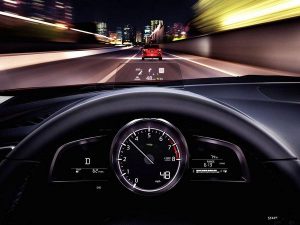
With the standard 2.0 engine and six-speed manual, you have a playful commuting companion. It’s not particularly speedy, but it is willing – which is what makes it fun. Anticipating – and taking advantage of – holes in traffic as they develop. Threading the needle.
With the optional 2.5 liter engine, you can exploit tighter gaps, windows that open a bit less wide (and close a bit faster).
Both of these high-compression engines are revvers – with redlines near 7,000 RPM – but the 2.5 liter is stronger in the lower and mid-ranges because of its larger displacement and greater torque output. It is also the one to pick if you prefer an automatic – for just those reasons. Larger, higher-torque (and sooner torque) engines are almost always the best match for automatics.
But with either engine, the Three corners like Ali used to come out of the corners – light on its feet, weight shifting without any apparent effect on the thing’s balance. Mazdas – and not just the Three – do an amazing thing: They corner flat without riding hard. There is give without wallow.
The way the Three behaves brings back a ’70s memory of Pontiac’s WS6 ride and handling package, which made its first appearance as an option on the Trans-Am in 1978. Pontiac used relatively soft springs and shock valving in tandem with huge-diameter front and rear anti-roll bars to produce one of the first American cars that was even better in a curve than it went down a dragstrip – while riding as comfortably as a Cadillac (back when Cadillacs were comfortable).
Mazda achieves the same effect using the electronics – the stability/traction control system – to shift the Three’s weight balance in such a way as to compensate for g loading as the car corners. This is called G Vectoring Control – an upgrade for the new model year.
Similarly, the seats manage to be both soft and supportive. The Gran Touring trim’s perforated leather chairs especially.
This is a comfortable cross country car as much as it’s a superlative commuter and a hot dog in the corners.
Functionally, the only thing not to like – which takes away from it being a driver’s car – is the new electric/push-button parking brake, which has replaced the pull-up emergency brake lever used last year. No more parking brake 180s.
That and the great-looking but functionally clunky LCD/infotainment system – which requires “two step” operation to operate some of its functions. For instance, to change the function at hand, you must first rotate the small knob to select << (down) or >>>(up) and then push down on the large rotary knob to engage.
The car’s looks do not jibe with its price.
Its proportions are most un-entry level. In particular, the proportionately long front end and hood – which gives it the appearance of a larger, rear-drive car. Most FWD cars are stubby – especially the compact-sized ones. Their engines – mounted sideways – are tucked up tight against the firewall and usually, there’s not much metal forward of the cowl.
Here, there is a voluptuous surplusage of car ahead of the cowl.
You almost expect to find a big six (or maybe even a V8) under the Three’s almost BMW Z4-suggestive hood/front clip.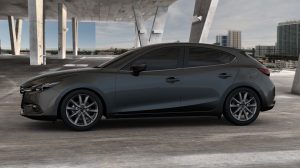
But beauty has its price.
It’s not a killer, but it’s got to be mentioned. Both the sedan and the hatchback have less backseat legroom (35.8 inches) than more practicality-minded rivals like the Civic (37.4 inches) and Corolla (41.4 inches, class best – by far) and the sedan has a small trunk, even for a small car – just 12 cubic feet vs. 13 cubic feet for the Corolla and a class-best 15.1 cubic feet (about as much as many mid-sized sedans) for the exceptionally space-efficient Civic.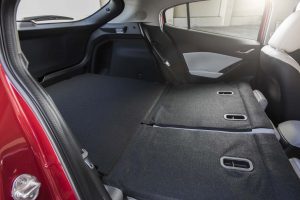
But, you can almost double the sedan’s cargo capacity to 20.2 cubic feet behind the rear seats – if you opt for the five-door hatchback. And with the second row seats folded flat, the hatchback’s available cargo capacity opens up to 47.1 cubic feet.
Whether sedan or hatch, you will get an exceptionally well-equipped car – even the base Sport trim. It comes standard with both a tilt and telescoping steering wheel, a six-speaker HD stereo, AC, power windows,locks and cruise control – plus a class-largest 7 inch inch (the Civic comes standard with a 5 inch) LCD touchscreen display for the apps.
The mid-range Touring trim adds 18 inch wheels (16s are otherwise standard), heated front seats, climate control AC and leather/leatherette interior trim plus some of the electronic safety stuff, such as the automated braking system.
Go for the Gran Touring and you’ll get a heated steering wheel on top of that, a nine speaker Bose premium stereo rig, LED exterior lighting, sport bike-style digital gauge cluster, full leather interior and a heads-up display.
If Mazda offered massaging seats and an 18 speaker ultra-premium audio – as were available in the new BMW 5 I reviewed last week and stickered the thing for say $28k it’d be nightmare for BMW.
And Benz and Lexus and the rest.
This is no idle day tripping. It is already happening. The fact that you can get things like a HUD and a heated steering wheel, automatic braking and a color seven inch touchscreen in an “entry level” car speaks volumes about what “entry level” means in 2017.
And what “luxury” means, too.
A small gripe that has to do with the Three’s luxury-car layout: It (just like the BMW 5 I had last week) has a pretty but puny center console storage cubby that has room for a sail fawn and a pack of cigarettes, maybe. Not much else.
It seems the one thing that economy cars – the real Blue Light Special ones – still have that the “luxury” entry level ones like this Three lack is a center storage cubby that has capacity.
One other small thing: The power point is located not-conveniently inside the center cubby, also which means having to run the wire from inside there to wherever your accessory (like my radar detector) is mounted. Also, it stays hot all the time – even with the ignition off – so you’ll want to unplug your accessory before you leave the car for the night – else your accessory will be powered up all night.
THE BOTTOM LINE
It’s smaller . . .and that’s about all that you can point a finger at and say “entry level.”
Don’t forget: No turbos.
And, the clutch.
We are low this month (see here).
If you like what you’ve found here, please consider supporting EPautos.
We depend on you to keep the wheels turning!
Our donate button is here.
If you prefer not to use PayPal, our mailing address is:
EPautos
721 Hummingbird Lane SE
Copper Hill, VA 24079
PS: EPautos stickers are free to those who send in $20 or more to support the site. 


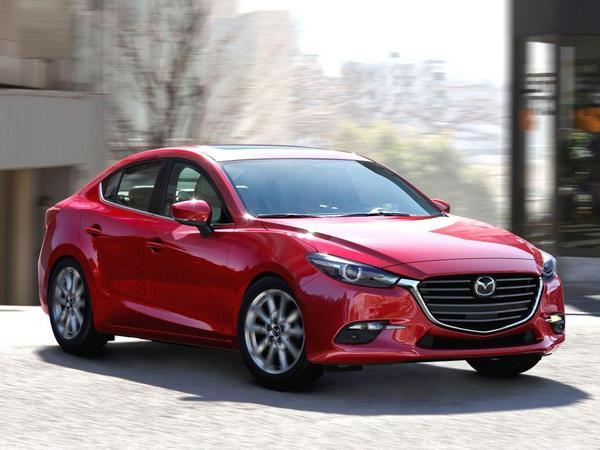



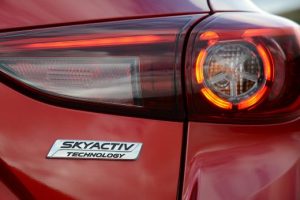

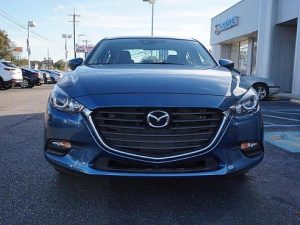
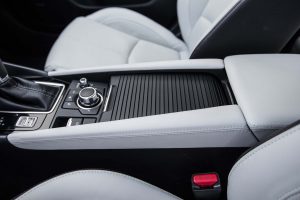






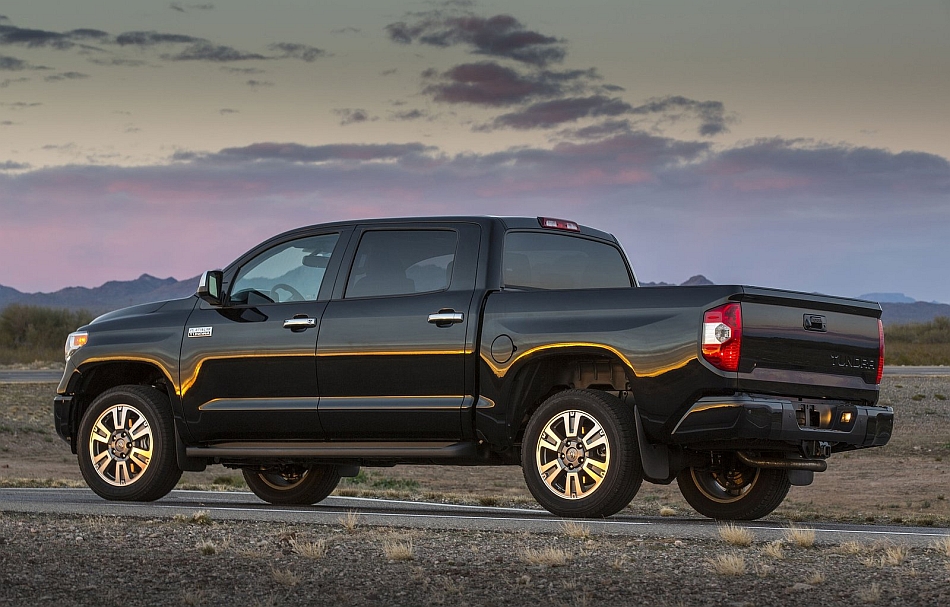
My son owns the sedan with the smaller engine and a manual transmission. He removed the muffler (yes, completely removed, not replaced), and put a cold air intake on it. What that means for me is that when I drive it I can actually hear the engine and shift by sound. It’s a fun car to drive and certainly doesn’t feel cheap. Sure would be amazing if it had some more power. It definitely feels better to drive than its rivals.
Here’s a weird question that your comment on the handling system of this car (that uses selective braking to tighten up a line) made me wonder. Do modern stability control systems partially negate the police PIT maneuver?
The PIT maneuver is a technique that police are trained to use in order to stop a car chase. It requires the police car to tap the rear corner of the pursued car from the side using the opposite front corner of the police car. It’s a sort of clipping, sideways motion that induces loss of traction at the rear tires. It usually causes the pursued car to lose control, often spinning into a 180 degree turn and coming to a stop. It is a highly dangerous maneuver that has been banned by many police forces because it can cause the pursued car to veer into dangerous areas (oncoming traffic, etc) and requires very precise car control on the part of the police (who are notoriously far worse drivers than the average citizen), and should only be used at fairly low speeds.
Regardless of the percentage of time that this maneuver is used to stop a real crime (vs. a victimless “crime”), I would think that traction and stability control systems in most new cars would neuter this a lot, especially in FWD cars that still have full power to the drive wheels in such a situation (and in the case of the Mazda3, can selectively brake a wheel to recover the car). Haven’t heard much about the PIT maneuver in recent years. Maybe this is why.
Dear SJ,
“and requires very precise car control on the part of the police (who are notoriously far worse drivers than the average citizen)”
Ain’t that the truth. Not to mention notoriously far worse shots than the average civilian gun enthusiast.
When I lived in Houston, I belonged to a gun club that allowed the Houston cops to hold their annual “qualification” shoots. I got to see just how crappy big city cops’ shooting skills were.
“Minute of pie plate” groups, at pistol ranges, no less, to make a long story short.
By contrast, most of the civilian shooters shot cloverleafs.
The Three is Mazda’s smallest, least-expensive car . . .
Isn’t the Two Mazda’s smallest, least expensive car?
Albeit, not by as much as one has a right to expect. The last time I checked, the Two was only very slightly cheaper than the Three, making the Three a hell of a bargain by comparison. Only a couple of thou more, and you got a lot more car.
Not sure how Mazda marketing experts set the MSRPs on these two models. Go figure.
Good morning, Bevin!
Mazda doesn’t sell the 2 in the United States . . . at least, not under the Mazda label. They sell it to Toyota, which re-sells it here as the Yaris iA.
Dear Eric,
Ah… I see.
Well, fortunately as I mentioned, the 3 is apparently much more car for only a little bit more money, so it’s just as well.
The Mazda2 was only briefly on sale in the US a few years ago. Same for the Audi A2, incidentally.
Dear SJ,
I’m guessing Mazda decided the US market wanted larger cars, and that the Mazda 2 was just below the size threshold.
Even here on Taiwan, where smaller cars are the norm, Mazda 3s outnumber Mazda 2s.
I’ve been considering a new Mazda as an option in a nicer daily utility ride than my old Protege but I my ’12 Mustang has enough electronics for the whole fleet and it doesn’t even have a touch screen. I hate touch screens. Especially in something I don’t want to be looking at because I am doing something else like driving. Electronic parking brake sounds like something that will result in a crippled car if it should be called upon to hobble the car home. Although MTs are very important to me. More than enough to overcome touch screen hate. I’ll probably keep the old car going though.
Hi Brent,
Touchscreens are practically inescapable now… if you want a new car. I doubt there are any 2017 models that do not have one. Maybe the base Nissan Versa, but I bet even that one has/will soon have one. Electric parking brakes are not yet de facto standard equipment but I expect they soon will be, too. Too much control left to the driver. Can’t have that. Not to mention, one more piece of expensive electronic crap to fail down the line and ka-ching you with repair costs!
Touchscreens were frowned upon by Mercedes, of all companies, such that you were required to use their COMAND scroll knob input instead. Similarly, BMW demanded all screen interaction happen via i-Drive inputs and didn’t have a touch screen. That was as recently as two years ago, so it may have changed now.
More to BrentP’s question, though, Honda tends to not use touch screens on their lower trim levels, even in Acuras. You’ll forgo things like navigation systems, but it may be worth it. They still do that weird dual screen thing where some systems display on a small screen up high on the dash and other systems display on a larger screen down low in the dash (and sometimes there’s a third screen between the speedo and tach).
Hi SJ,
Not anymore (per Inspector Clouseau). Touchscreens are now the de facto standard in all new cars…
No doubt this shows my age but I recall having very specific moves that involved the e brake ala The Bat Turn, a 180. So, what did I use it for? Grins, pure and simple…….but I bought my own tires. I made it my mission in life to turn “you can outrun the cops but you can’t outrun Motorola” that saying into the lie it was. Nobody said I had to stay on the same road and the one time I knew for a fact a road block had been set up to catch me, it was set up “behind” me. They didn’t anticipate I was long gone when all the DPS merged at an intersection. I was sitting at a service station(yall remember those dontcha?)35 miles away just bsing with the owner when the guy I had been racing pulled in there. He was a bit miffed and more than a bit reamed since they caught him. He couldn’t tell them anything since we’d never seen each other before but he did sorta get a laugh when he saw me and realized I was long gone. Not my first rodeo and not my last by a long shot.
In daylight I got away from a chaser and followed him around looking for me. The little devil on my shoulder made me get close enough to him and burn tires right behind him turning the opposite direction. Here we go again. I drove to the house and parked my car and watched the entire sheriff dept. and DPS look for me from the safety of my old pickup.
“Standard LCD touchscreen is large but still back and white…”
Color screens I’m familiar with are about impossible to discern in the sun – would much prefer
black and white – including smart phones.
You lost me at the Electronic Handbrake. I will not have another car with one of these things. Sure they free-up space on the console but more importantly for manufacturers, they are cheaper. They are also less reliable and cause more difficulty changing brake pads. After a little over a year driving an Audi A3 with an Electric Handbrake I said, No Mas. I tired of the anxiety of whether or not the brake would release if I operated it at a traffic light or started on a hill and it was nearly impossible to drive onto ramps so I could change the oil. One of the main reasons I didn’t buy an Audi TT is because of this Handbrake and I have written-off new Porsches as well. Some people have said I am too extreme on this subject but last week, while exiting the gym, I saw an Opel which could not reverse out of its parking space because the Electronic Handbrake would not release.
I am with you, Doug… unfortunately, this is a trend (like pushbutton ignition) that is probably unstoppable…just another reason to stick with the old stuff! 🙂